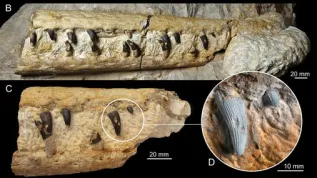
While shale gas extraction is not an easy task and a burden for the environment, with the growing energy needs of the world, we cannot avoid it, believes the director of the National Research and Development Centre, Prof. Krzysztof Jan Kurzydłowski.
Prof. Krzysztof Jan Kurzydłowski gave the lecture "Shale gas without dogma" at a meeting of Warsaw Science Festival Science Cafe.
He explained that shale gas is quite difficult to extract. Gas is not only located deep underground (in Poland even at a depth of 3 km), but in addition enclosed in the rock. Gas is located in the follicles, which are not interconnected - they are separated by rock. Gas does not escape from the rock so as easily as water drains freely from a soaked sponge, it is rather like juice imprisoned in an orange or oil in sunflower seeds. In order to reach the gas, you have to break down structure - crush the rock - at each point, and free the gas from each follicle.
The speaker explained that to reach the deposit one must first bore vertically, and then further horizontal drilling is needed underground. There, rocks must be crushed (e.g. using microblasting) and gas extracted. In place of the gas, water with special additives is pumped. Liquid should make the gas permanently able to move within the rock.
It would seem that the process of extracting shale gas is very difficult and unprofitable. Prof. Kurzydłowski noted, however, that extraction of shale gas not only allowed the United States, formerly one of the largest importers of natural gas, to become self-sufficient, but also to consider gas exports.
In Poland, shale gas extraction may be less profitable. Compared to deposits in the United States, Polish deposits are of low and medium quality - there is less gas in the rock and it is present in smaller follicles, making reaching it more difficult. In addition, shale gas deposits are found in the belt from Gdańsk through Warsaw to Lublin. The deposits are often under areas of high landscape value and a high population density. In the United States, gas shale is mined in places of lesser importance. In addition, the geological conditions in Poland are different than in the U.S., so we can not directly apply the technology already used in the U.S. Kurzydłowski stressed that only experience of the first drilling in Poland will provide more information.
Kurzydłowski admitted that shale gas extraction technologies are an environmental burden. He noted that the water pumped underground contains ingredients such substances that increase viscosity - these could be harmless substances used in the food industry - and backfilling materials. These are the so called "proppants" that look like ceramic balls that prevent the rock from closing and ensure the continued the movement of gas in the cracks. According to Kurzydłowski, the fluid pumped into the ground is not very harmful. A bigger problem for the environment is the fact that shale gas extraction requires huge amounts of water, which for many years and in vast areas would need to be pumped into the ground. And this would be quite cumbersome in Polish conditions. "The key, however, is not how much water must be pumped into the ground, but rather - how much of this water can be recovered" - said the director of the National Research and Development Centre.
Prof. Kurzydłowski noted that the growth in demand for electricity is greater than the population growth. "If we can not change the energy balance, we are doomed to mine shale gas" - he said. He added that before we decide to do this, cold calculation is needed that will help make rational decisions.
PAP - Science and Scholarship in Poland
lt/ ula/ mrt/
tr. RL













